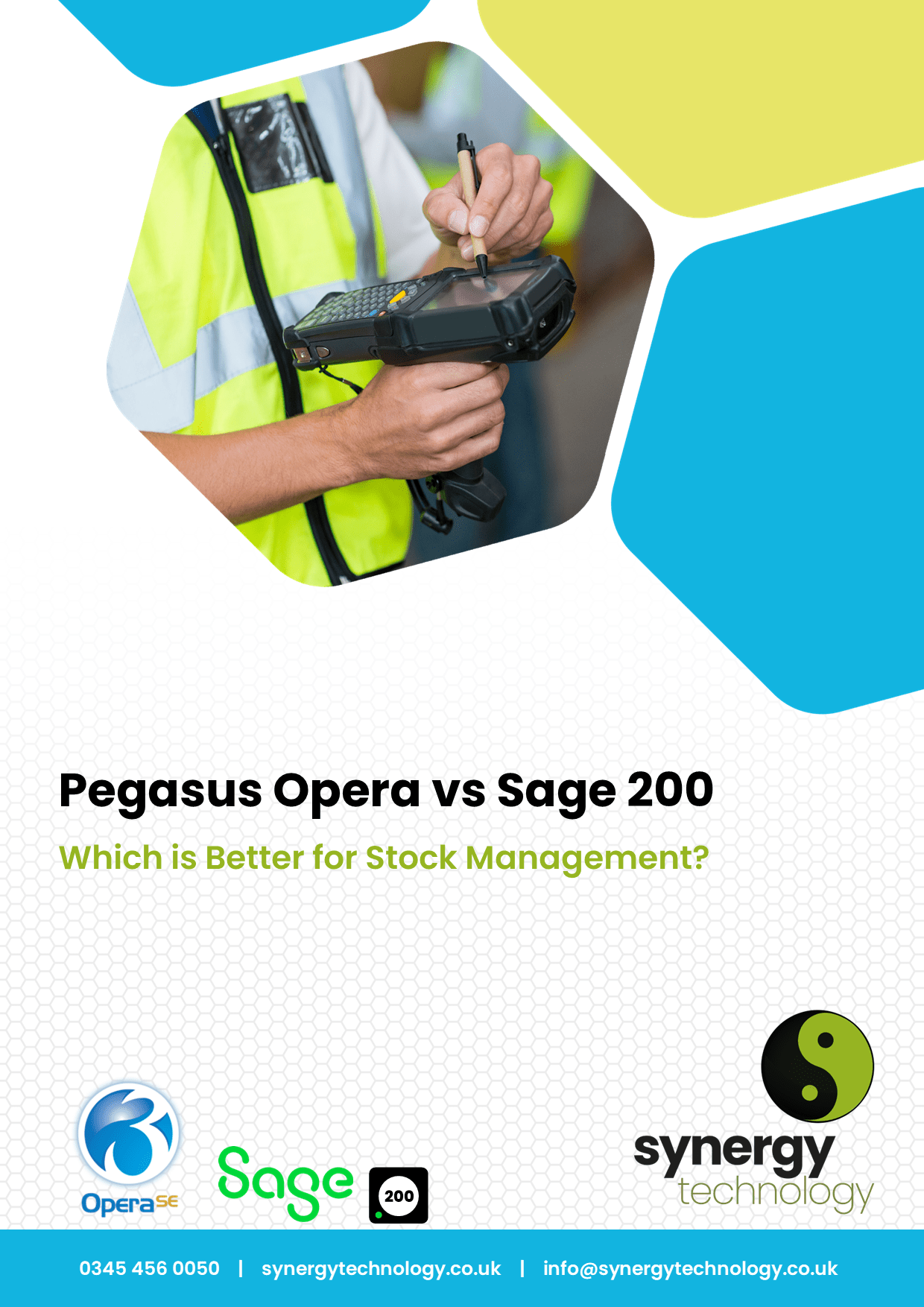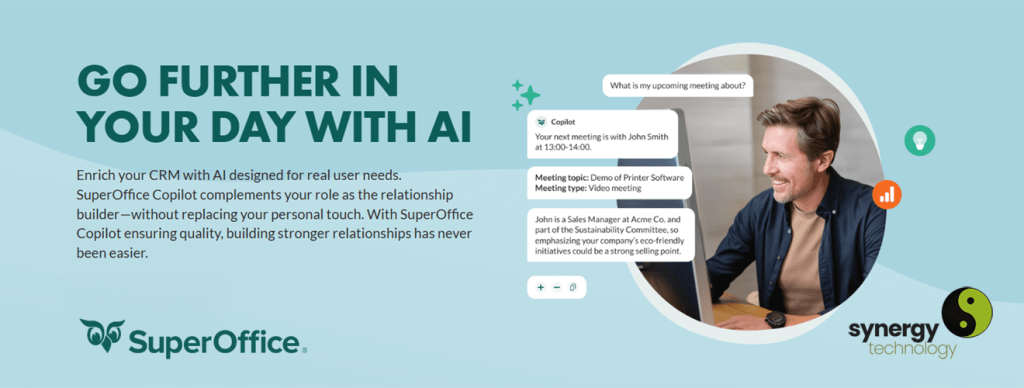Introduction
When it comes to managing stock efficiently, choosing the right software can make all the difference to operational success. Two of the most popular ERP (Enterprise Resource Planning) solutions for small and medium-sized businesses in the UK are Pegasus Opera 3/SE and Sage 200. Both platforms offer powerful tools to streamline financial management, sales, purchasing, and stock control, but which one is best for small and medium sized enterprises (SMEs)?
While Sage 200 has carved out a strong presence in the mid-market sector, Pegasus Opera 3/SE offers a tailored, cost-effective, and intuitive solution for businesses that require more granular control over their inventory without the complexity or overhead of a larger system.
This document explores which is the superior choice for stock management between two of the leaders in the sector, Pegasus Opera and Sage 200. We will evaluate both systems across key areas such as ease of use, stock control features, real-time updates, forecasting, and integration with wider business functions.
Introduction to Pegasus Opera 3/SE and Sage 200
Pegasus Opera 3 & Opera 3 SE developed by Pegasus Software, is an all-in-one modular solution ideal for small to medium-sized businesses. It includes comprehensive tools for financials, payroll, CRM, and crucially, advanced stock management.
Opera 3/SE is known for its ease of use, detailed reporting, and flexible setup, making it particularly appealing to SMEs that want powerful features without high overheads or excessive complexity.
Sage 200 is a modular business management solution aimed at medium-sized companies, offering core functionality such as financials, supply chain management, manufacturing, and project accounting.
Sage 200 is highly scalable, designed to support growing businesses with relatively complex needs. The system has a reputation for robustness and is often favoured by larger teams requiring a centralised system across multiple departments.
Ease of Use and Setup
One of the biggest considerations for SMEs is how quickly and easily a system can be implemented and adopted by staff. In this respect, Pegasus Opera 3/SE has a clear advantage.
Opera 3/SE features a straightforward, intuitive interface that mirrors familiar Microsoft Windows environments. Navigation is logical, with clearly defined modules and workflows that make training quick and system adoption easy. Setup can often be completed with minimal disruption, and customisation options allow businesses to configure the software according to their own processes without the need for extensive coding or consultancy.
In contrast, Sage 200, while powerful, is more complex to set up and typically requires more time and external support for configuration and onboarding. Its steeper learning curve can be a barrier for smaller businesses with limited IT resources. As such, Pegasus Opera 3/SE offers a more accessible starting point, especially for companies upgrading from manual processes or older systems.
Real-Time Stock Updates
Keeping an accurate view of stock levels in real time is critical to preventing stock-outs or overstocking. Pegasus Opera 3/SE ensures that all stock movements whether from sales, purchases, returns, or transfers, are instantly reflected across the system.
This real-time visibility is particularly useful for businesses with fast-moving or high-value stock, as it supports informed decision-making and quick reactions to changes in demand or supply. Opera 3/SE’s integration between modules means stock updates automatically feed into sales, purchasing, and financial ledgers without manual intervention.
Sage 200 also supports real-time stock visibility, but it often requires more back-end configuration and system knowledge to ensure data synchronisation across departments. Opera 3/SE’s simplicity gives SMEs a more user-friendly and reliable experience out of the box.
Comprehensive Reporting and Analysis
One of Pegasus Opera 3/SE’s standout strengths is its reporting engine. The system includes a powerful set of predefined stock reports covering movements, ageing, profitability, stock valuations, and sales trends, while also allowing users to create custom reports using tools like Pegasus XRL, which integrates directly with Microsoft Excel, or Pegasus Data Connector for Opera 3 SE which allows connection to external reporting tools such as Microsoft Power BI.
Opra’s Excel integration is a major advantage, enabling users to analyse stock data with familiar tools and update reports in real time. Users can drill down from reports directly into the transactional data behind them, helping to identify trends and pinpoint issues quickly.
Sage 200 also offers strong reporting capabilities, but in many cases users need additional training or third-party tools to unlock the full potential of its Business Intelligence module. Opera 3/SE’s reporting is more accessible and tailored to the day-to-day needs of stock controllers, warehouse managers, and business owners alike.
Batch and Serial Number Tracking
For businesses that handle regulated goods, perishable items, or high-value stock, batch and serial number tracking is essential. Pegasus Opera 3/SE includes this capability as standard, allowing users to track goods through their entire lifecycle, from receipt to despatch, using batch numbers, serial numbers, or both.
This level of traceability is particularly valuable in industries such as manufacturing, healthcare, and food distribution. Users can assign expiry dates, control stock rotation (e.g., FIFO), and perform recalls or audits quickly and accurately when needed.
Sage 200 supports batch and serial tracking too, but in many cases, these features must be enabled via separate modules or advanced configuration. All this means that Pegasus Opera 3/SE provides a more seamless, built-in experience, which means a lower cost of implementation and faster access to critical traceability functions.
Integration with Other Business Functions
Opera 3/SE isn’t just a stock control system, it’s a fully integrated business suite. Its modular design means stock control integrates smoothly with sales, purchasing, CRM, finance, payroll, and business intelligence tools.
For example, when a sales order is processed, stock is immediately updated and relevant financial entries are generated in the accounts module. Customer service teams using the CRM module can see stock availability and order history in real time, supporting better customer interactions. All modules communicate with one another, ensuring consistency and eliminating data silos.
Sage 200 also offers strong integration between its modules, but its architecture often makes it feel more segmented. Additional third-party solutions are sometimes required to bridge gaps between functions, increasing cost and complexity. In contrast, Opera 3/SE’s tightly integrated environment gives SMEs everything they need in one place.Cost-Effectiveness for Smaller Businesses
When evaluating ERP systems, total cost of ownership is a critical factor, especially for SMEs with limited budgets. Pegasus Opera 3/SE is known for offering exceptional value for money, delivering enterprise-grade features without the high licensing, support, and consultancy fees associated with larger systems like Sage 200.
Because many advanced features in Opera 3/SE are included as standard or available through modular upgrades, businesses can avoid paying for unnecessary functionality. The cost of training, setup, and ongoing maintenance is also typically lower thanks to the system’s ease of use and simplicity.
Sage 200, by comparison, can become significantly more expensive due to its modular structure, licensing model, and the need for external support. While it may be appropriate for larger or more complex organisations, it often exceeds the requirements, and budgets, of smaller businesses.
Conclusion: Opera 3/SE is the Clear Winner
While both Pegasus Opera 3/SE and Sage 200 are powerful ERP systems, Pegasus Opera 3/SE consistently proves to be the better choice for stock management among small to medium-sized UK businesses. Its intuitive interface, advanced stock control features, real-time data updates, and built-in traceability offer unmatched flexibility and ease of use. Combined with its cost-effectiveness and seamless integration with wider business functions, Opera 3/SE stands out as the more practical and scalable solution for growing companies.
For SMEs seeking to streamline their inventory processes, improve reporting, and maintain tighter control over stock without the overhead of a large-scale ERP deployment, Pegasus Opera 3/SE is the clear winner.
The Synergy Technology Difference
The team at Synergy Technology are amongst the best, most experienced people in the industry in terms of successful Pegasus Opera deployments.
You will get a team who will work in partnership with you to ensure your business application delivers real, meaningful benefits, driving strategic change and improving efficiency. You will be looked after by a team that truly cares, is completely transparent and delivers exacting solutions every time.
We’ve been at the forefront of ERP technology for over 25 years and have worked with hundreds of businesses in a range of industries, so are well placed to help and advise you at every stage of your ERP journey.
Click the picture to the right to download the whitepaper.
A summary of what this guide covers:
- Introduction to Pegasus Opera 3/SE and Sage 200
- Ease of Use and Setup
- Real-Time Stock Updates
- Comprehensive Reporting and Analysis
- Batch and Serial Number Tracking
- Integration with Other Business Functions
- Conclusion
- The Synergy Technology Difference
Want more information about Pegasus Opera?
Synergy Technology is proud to be a partner of Pegasus Opera. We also offer implementation, support and integration with a number of other platforms. Find out more by visiting our add-ons and integrations page, call us today on or visit our contact page to send us an email.








